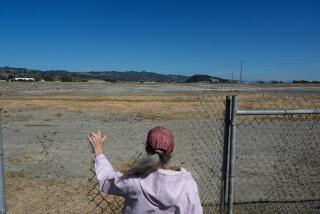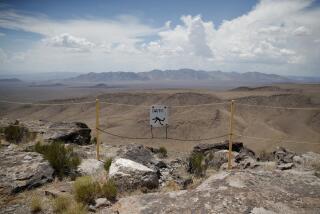After 25 Years, Nation’s First Nuclear Dump Gets a Truckload of Waste
- Share via
CARLSBAD, N.M. — After 25 years of lawsuits, studies and protests, the nation’s first nuclear dump--a network of chambers carved out of the salt beds deep beneath the New Mexico desert--received its first truckload of radioactive waste Friday.
A crowd of about 100 people who live in Carlsbad, 25 miles from the Waste Isolation Pilot Plant, cheered the truck and held up cardboard signs reading, “Welcome finally” and “It’s about time!” as the rig rolled through before daybreak.
Earlier in the 270-mile, 7 1/2-hour trip, the truck faced a scattering of protesters yelling, “Poison! Poison!” along with two young women who sat down in the road and a man who tried to block the highway with his car.
The first load of waste came from Los Alamos National Laboratory in the New Mexico city that was the birthplace of the atomic bomb.
Ultimately, up to 6.2 million cubic feet of waste generated since the dawn of the Atomic Age will be entombed over the next 30 years in the salt beds nearly a half-mile below ground. The waste consists of such items as clothing, tools and rags contaminated with plutonium.
Up to now, the United States has had no permanent resting place for weapon-related plutonium waste.
As a result, the waste has been piling up at 23 weapon installations around the country, such as Rocky Flats near Denver and the Idaho National Engineering Laboratory, where it is kept mostly in 55-gallon drums on above-ground concrete pads, underneath bubble structures or in earthen mounds.
These corroding drums must be periodically repackaged, and some fear the waste is vulnerable to hazards such as tornadoes or earthquakes.
The arrival of the first shipment of waste at WIPP marked more than two decades of effort to open the $1.8-billion repository, first proposed in 1974. The first truckload will be placed underground by Monday.
“I’m ecstatic. This is just the culmination of everything I’ve worked for for 25 years,” said Wendell Weart, a Sandia National Laboratories scientist who was instrumental in creating the repository.
WIPP is not designed for the thousands of tons of high-level waste stored at nuclear power plants across the country. Yucca Mountain in Nevada is being studied as a long-term burial place for that waste.
An appeals court in Washington and a federal judge in Santa Fe on Wednesday rejected last-ditch appeals from environmentalists who sought to stop the transfer of the waste to WIPP.
In Santa Fe, a hub of anti-WIPP sentiment, dozens of protesters lined the truck’s route, holding up placards that read, “Stop nuke trucks” and “Science or science fiction?”
William Beems, 42, of Albuquerque, parked his car across the middle of the road with lighted flares around it. He was arrested on charges of obstructing the road and resisting arrest.
The two young women who sat down on the interstate south of Santa Fe moved when asked to do so by state police.
The 18-wheeler passed through WIPP’s white metal gates at 3:36 a.m. to the cheers of about 500 employees and dignitaries. WIPP employees waved American flags and jumped up and down.
More to Read
Sign up for Essential California
The most important California stories and recommendations in your inbox every morning.
You may occasionally receive promotional content from the Los Angeles Times.










